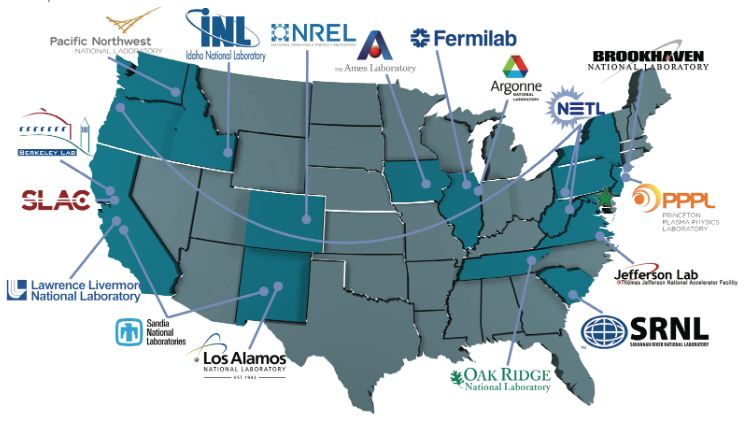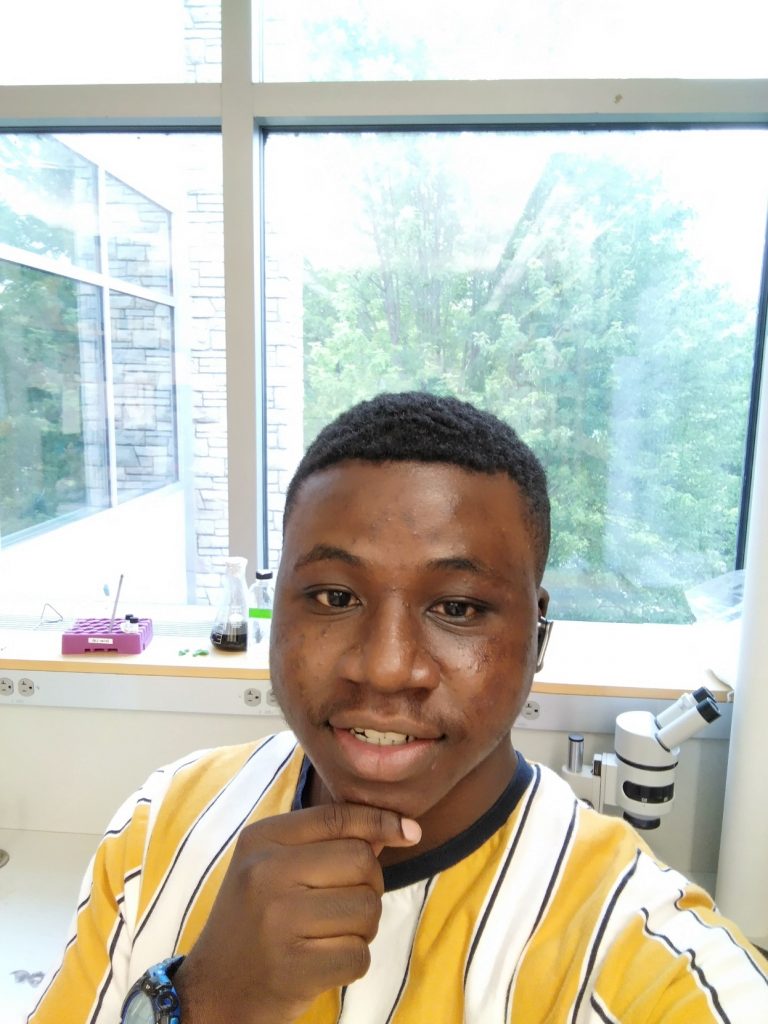There are 17 Department of Energy (DOE) national labs in the US, each dedicated to discovering, synthesizing, and manipulating scientific data and findings. Below is a brief review of 10 national labs, along with links to their job openings and undergraduate programs.
1. Ames National Laboratory
Ames National Lab, an Iowa-based institution, conducts both fundamental and applied research that helps the world better understand chemistry, physics, and materials science. It is operated by Iowa State University under contract with the U.S. Department of Energy. They also have an internship program called the Science Undergraduate Laboratory Internships (SULI) program. This is a premier Department of Energy internship designed to bring undergraduates into the laboratory research setting at Ames National Laboratory and Iowa State University to work with scientists who are leaders in their research fields (Link To Their Undergraduate Internship).
Check out Their Website for more information: https://www.ameslab.gov/
2. Argonne National Laboratory
Argonne is a multidisciplinary science and engineering research center, where talented scientists and engineers work together to answer the biggest questions facing humanity, from how to obtain affordable clean energy to protecting ourselves and our environment. It is found in Chicago, leading discovery and power innovation in a wide range of core scientific capabilities, from high-energy physics and materials science to biology and advanced computer science. (Check out their job openings: Here). They also have solid programs for undergraduates during the summer and within the academic year ( Click here to Check it out).
Also check out their website for more information: https://www.anl.gov/
3. Brookhaven National Laboratory
Brookhaven National Laboratory applies its expertise and world-class facilities to pressing scientific questions about everything from the fundamental forces of nature to the complex interactions of ecosystems and the environment. Located in Upton, New York, Brookhaven National Lab excels in designing, constructing, and operating large-scale, cutting-edge research facilities—some of which are unavailable anywhere else in the world. Among Brookhaven Lab’s current initiatives are nuclear science, energy science, data science, particle physics, accelerator science and technology, quantitative plant science, and quantum information. Check out their amazing educational programs on their website. Check out their undergraduate programs: Here
Fun Fact: They collect and study data from a Large Hadron Collider, the world’s most powerful particle accelerator, and use the collected data to explore the laws of physics at subatomic scales, test predictions of the Standard Model of particle physics, and search for signs of new particles and forces (Cool!! Read more here)
Check out their website for more information: https://www.bnl.gov/world/
4. Fermi National Accelerator Laboratory
Fermilab is America’s particle physics and accelerator laboratory. Their vision is to solve the mysteries of matter, energy, space, and time for the benefit of all. They strive to lead the world in neutrino science with particle accelerators, lead the nation in the development of particle colliders and their use for scientific discovery, and advance particle physics through measurements of the cosmos. They are found in Batavia, Illinois (on a 6,800-acre site) and managed by the Fermi Research Alliance LLC for the U.S. Department of Energy Office of Science. They also have over 2,000 employees ranging from engineers to administrative professionals (Check out their job openings: Here).
Also check out their website for more information: https://www.fnal.gov/
5. Lawrence Berkeley National Laboratory
Lawrence Berkeley National Lab is managed by the University of California for the U.S. Department of Energy’s Office of Science. Their core values are team science (solutions to complex problems), service, trust, innovation, and respect. Their mission is to expand the frontiers of knowledge and deliver solutions for science and humankind. The lab is located on Cyclotron Road, Berkeley. CA. They have approximately 16,350 researchers worldwide who use their facility, and about 1,800 scientists and engineers work in the facility. Check out their Science Undergraduate Laboratory Internship (SULI). They also partner with the Joint BioEnergy Institute to offer undergraduate research opportunities. (Read more)
Check out their website for more information: https://www.lbl.gov/
6. Oak Ridge National Laboratory (ORNL’s)
Oak Ridge National Laboratory was established in 1943 as part of the Manhattan Project and is building on a legacy of discovery and innovation to continually address the most urgent research and development (R&D) needs. They deliver scientific discoveries and technical breakthroughs needed to realize solutions in energy and national security and provide economic benefit to the nation. They address national needs through impactful research and world-leading research centers. ORNL’s world-class scientific user facilities are available to users from universities, industry, and other institutions. Here are their facilities: • Building Technologies Research and Integration Center • Carbon Fiber Technology Facility • Center for Nanophase Materials Sciences • High Flux Isotope Reactor • Manufacturing Demonstration Facility • National Transportation Research Center • Oak Ridge Leadership Computing Facility • Spallation Neutron Source. Check out their educational programs (Here)
Fun Fact: They organize the annual JUMP (Join the discussion, Unveil innovation, Make connections, Promote tech-to-market) STEM competition for undergraduate and graduate students at US colleges and universities (Read More)
Check out their website for more information: https://www.orni.gov
7. Pacific Northwest National Laboratory (PNNL)
Pacific Northwest National Laboratory is a different kind of national lab that advances the frontiers of knowledge, taking on some of the world’s greatest science and technology challenges. They have distinctive strengths in chemistry, Earth sciences, biology, and data science which are central to their scientific discovery mission. Their research lays a foundation for innovations that advance sustainable energy through decarbonization and energy storage and enhance national security through nuclear materials and threat analyses. PNNL collaborates with academia in fundamental research and with industry to transition technologies to market. Their researchers accept great challenges such as unlocking the mysteries of Earth’s climate, helping modernize the U.S. electric power grid, or safeguarding ports around the world from nuclear smuggling, for one purpose: to create a world that is safer, cleaner, more prosperous, and more secure. Each year they welcome over 1,500 interns from across the nation to join internship and research associate opportunities that open pathways for a variety of STEM careers in basic science, clean energy, national security, and more. Learn more about these opportunities that are available throughout the year and how they help their interns grow their network to position them for future success (Here)
Also check out their website for more information: https://www.pnnl.gov/
8. Princeton Plasma Physics Laboratory (PPPL)
This multimillion-dollar building will serve as an international hub of fusion research and a platform for new programs. Its modern and efficient design will support the Lab’s expanded scientific mission in microelectronics, quantum materials and devices, and sustainability science. They are studying ways to remove fossil fuels from industrial and manufacturing processes to contribute to a Net-Zero America, contributing to a sustainable future. They also strive to understand plasma from the lab to the cosmos, and for good reason: plasma, the fuel of fusion, makes up 99% of the visible universe, exploring the universe and beyond. Year-round internships are available, both paid and for credit – for students at 4-year and 2-year institutions. Work closely with a scientist or engineer on a cutting-edge project. Join Them! They also have a Science Undergraduate Laboratory Internship (SULI), program.
Also check out their website for more information: https://www.pppl.gov/
9. Stanford Linear Accelerator Center (SLAC) National Accelerator Laboratory
Their mission is to explore how the universe works at the biggest, smallest, and fastest scales and invent powerful tools used by scientists around the globe. Their research helps solve real-world problems and advances the interests of the nation. They are known for leading large-scale science projects, and we welcome scientists to use their X-rays, lasers, and electron beams for groundbreaking experiments. SLAC’s vision is to open new windows to the natural world and build a brighter future through discovery and innovation. They live by the values of excellence (being at high standards), integrity (being accountable), collaboration (being committed to the collective success of SLAC), respect, and creativity (exploring new ideas with courage). They have a workforce of nearly 1,700 creative, diverse, and united employees (Check out SLAC’s job openings Here). SLAC offers a variety of internship opportunities along with mentorship opportunities created to help students be successful in their career interests (Check Them out)
Also check out their website for more information: https://www6.slac.stanford.edu/
10. Thomas Jefferson National Accelerator Laboratory
Thomas Jefferson National Accelerator Laboratory lab capitalizes on its unique technologies and expertise to perform advanced computing and applied research with industry and university partners, and provides programs designed to help educate the next generation in science and technology. Scientists worldwide utilize the lab’s unique particle accelerator, known as the Continuous Electron Beam Accelerator Facility (CEBAF), to probe the most basic building blocks of matter – helping us to better understand these particles and the forces that bind them – and ultimately our world. One of their mission is to deliver discovery-caliber research by exploring the atomic nucleus and its fundamental constituents, including precise tests of their interactions. Thomas Jefferson National Accelerator Facility is entering an exciting period of mission growth and is seeking new team members ready to apply their skills and passion to have an impact (Check out their job openings here) They also have programs for undergraduates, which are mostly internships and other opportunities for students to get involved (Here). You can also check their website for more information: https://www.jlab.org/
Here are the links to the other National Labs in the United States:
11. Lawrence Livermore National Laboratory
12. Sandia National Laboratory
14 . Los Alamos National Laboratory
15. National Energy Technology Laboratory
16. National Renewable Energy Laboratory
17. Savannah River National Laboratory
Dennis Boakye ’26 is a rising junior with a major in Neuroscience and a minor in Mathematics. He is also a co-president of the Neurolawrence Club and the Synthetic Biology Club and the treasurer for the American Medical Student Association (AMSA, Lawrence Chapter) and the Black Student Union (BSU). Dennis is the current career peer educator for the Health and Medicinal Professions (HMP) and the Physical and Natural Sciences (PHN) career communities at Lawrence University. Connect with Dennis on LinkedIn.

